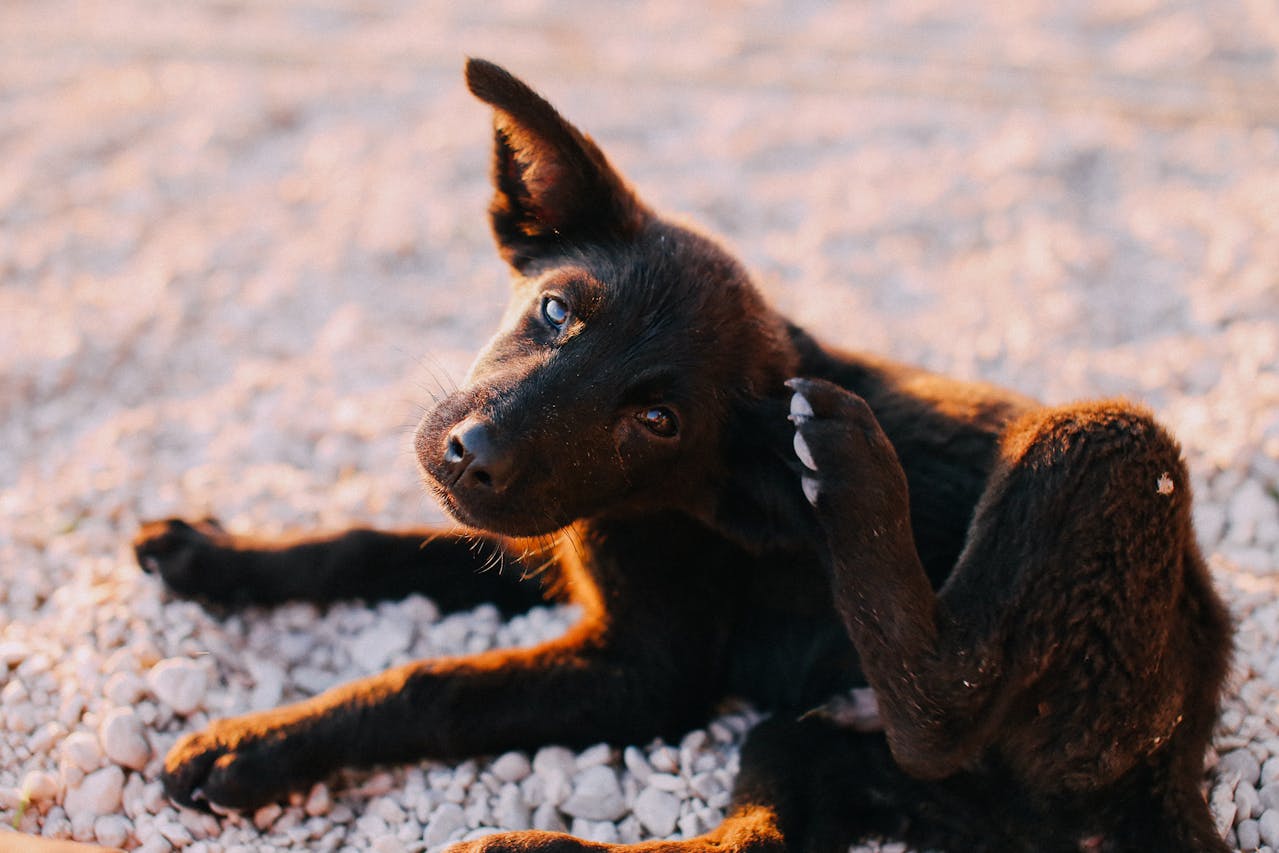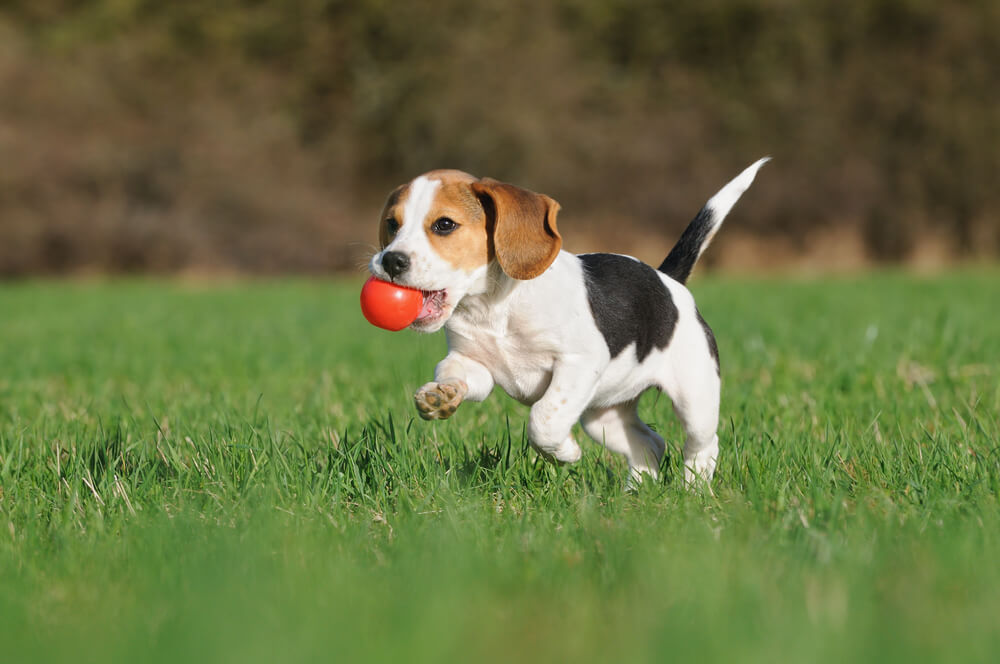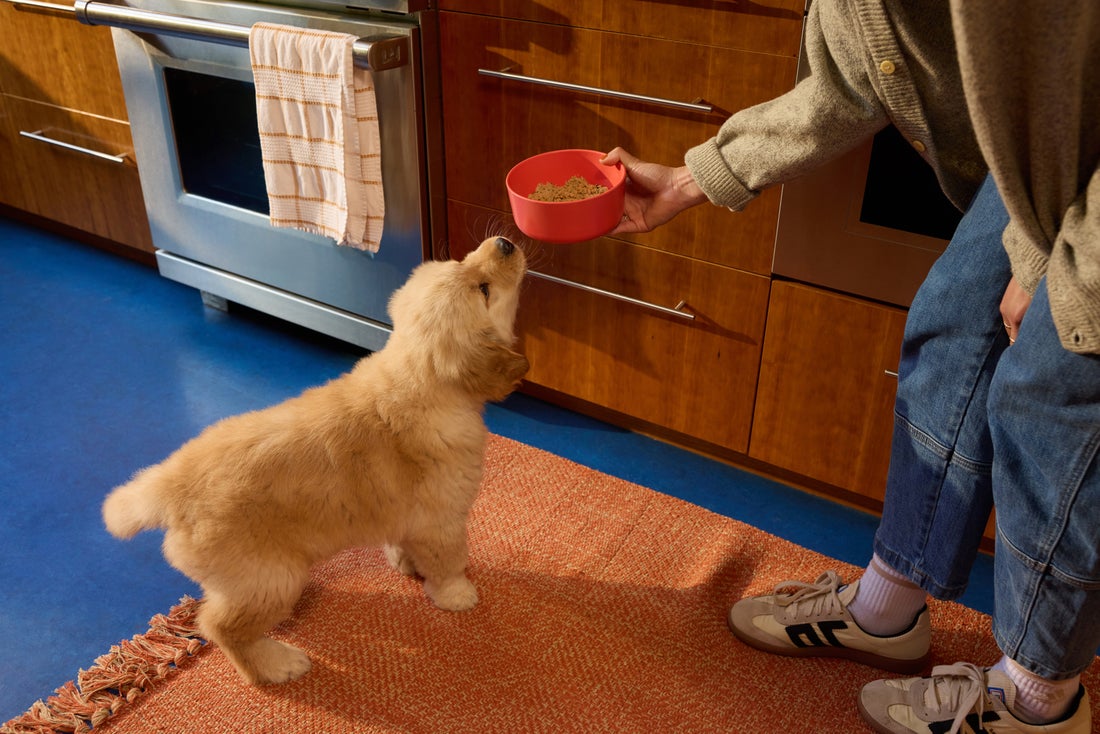Hey Ollie blog readers! We’re offering you an exclusive 60% OFF your starter box! Try now!
If your dog is dealing with allergies, itching, or anxiety, you may be wondering if Benadryl is a safe and effective solution. Benadryl, a common over-the-counter antihistamine, is often used to relieve allergy symptoms, motion sickness, and even mild anxiety in dogs. But is Benadryl safe for dogs, and how much should you give?
While Benadryl can be helpful in certain situations, it’s not always the best long-term solution. Frequent itching, allergies, or anxiety may be signs of underlying health issues, and simply masking symptoms with medication isn’t ideal. Factors like diet, environment, and overall wellness play a huge role in your dog’s health. For example, a fresh, high-quality diet—like the nutritious, human-grade meals from Ollie—can help support immune function and reduce allergy symptoms naturally.
In this guide, we’ll cover everything you need to know about Benadryl for dogs, including its uses, dosage, side effects, and alternatives. By the end, you’ll know when Benadryl is appropriate, how to use it safely, and what natural options might work even better.
Key Takeaways
- Benadryl can help with allergies, anxiety, and motion sickness in dogs, but proper dosage is crucial.
- Side effects like drowsiness are common, and some dogs shouldn’t take Benadryl due to health conditions.
- Daily use isn’t ideal—fresh, high-quality food like Ollie can help manage allergies naturally.
Can Dogs Have Benadryl?
Yes, dogs can have Benadryl, but it should only be given under the right circumstances and at the correct dosage. Benadryl (diphenhydramine) is an over-the-counter antihistamine commonly used to treat allergies, insect bites, motion sickness, and mild anxiety in dogs. While it’s generally safe when used properly, it’s not the best solution for all dogs or conditions.
When is Benadryl Safe for Dogs?
Benadryl can be a helpful option for short-term relief in cases like:
- Seasonal or environmental allergies (itchy skin, sneezing, watery eyes)
- Bug bites or stings that cause swelling or mild allergic reactions
- Motion sickness during car rides or travel
- Mild anxiety from thunderstorms or vet visits
When Should You Avoid Giving Benadryl?
Not all dogs can tolerate Benadryl safely. Avoid giving it if your dog:
- Has heart disease, glaucoma, or high blood pressure
- Takes other medications that may interact negatively
- Is pregnant, nursing, or a senior with health issues
- Shows severe allergic reactions (like swelling of the face or difficulty breathing—these require emergency vet care)
Benadryl Typically Isn’t a Long-Term Solution
While Benadryl can ease allergy symptoms, it doesn’t fix the root cause. Frequent allergies may indicate a dietary issue, and processed foods with fillers can make them worse. Switching to a fresh, nutrient-dense diet—like Ollie fresh dog food—can help strengthen your dog’s immune system and reduce allergy flare-ups naturally.
What is Benadryl?
Benadryl is the brand name for diphenhydramine, an antihistamine commonly used to treat allergies in both humans and dogs. It works by blocking histamines—chemicals the body releases during an allergic reaction—to reduce symptoms like itching, swelling, and sneezing.
How Does Benadryl Work in Dogs?
When a dog experiences allergies, their immune system overreacts to triggers like pollen, dust, or insect bites. This releases histamines, leading to itching, swelling, and inflammation. Benadryl blocks these histamines, providing relief from symptoms.
Forms of Benadryl for Dogs
Benadryl is available in different forms, but not all are safe for dogs:
- Tablets & Capsules – The most common and easiest to dose form for dogs.
- Liquid Benadryl – Can be used, but many liquid versions contain xylitol or alcohol, which are toxic to dogs. Always check the ingredients.
- Topical Benadryl (Creams & Gels) – Used for localized itching or skin irritation.
- Children’s Benadryl – Sometimes recommended for small dogs, but always confirm with your vet first.
Is Benadryl a Prescription Medication?
No, Benadryl is an over-the-counter (OTC) medication, meaning it doesn’t require a prescription. However, just because it’s easily accessible doesn’t mean it’s always safe—always check with your vet before giving Benadryl to your dog, especially if they have health conditions or take other medications.
Benadryl For Dogs Use Cases
Benadryl is commonly used to treat a variety of mild health issues in dogs. While it can provide relief in certain situations, it’s important to use it appropriately and not as a long-term solution. It is typically recommended to speak with a veterinarian before introducing a new medication to your dog but below are a few of the most common uses for Benadryl for dogs:
1. Allergies
Benadryl is most often used to relieve allergy symptoms, including:
- Seasonal allergies (pollen, grass, mold)
- Environmental allergies (dust mites, household cleaners, perfumes)
- Food allergies (though diet changes are a better solution)
- Insect bites & stings (mosquitoes, fleas, bees)
Important Note: If your dog experiences frequent allergies, relying on Benadryl alone isn’t ideal. Diet plays a major role in allergy management. Many commercial dog foods contain fillers and artificial ingredients that can trigger allergic reactions. A fresh, high-quality diet, like Ollie human-grade meals, can support your dog’s immune system and reduce allergy symptoms naturally.
2. Motion Sickness & Travel Anxiety
Benadryl’s mild sedative effect can help dogs who experience nausea or anxiety during car rides or flights. However, if your dog gets anxious often, other natural solutions like calming treats, training, or a diet rich in omega-3s may help more effectively in the long run.
3. Mild Anxiety & Stress
Some vets recommend Benadryl for mild cases of anxiety, such as:
- Fear of thunderstorms or fireworks
- Stress from vet visits or grooming
- Separation anxiety (mild cases)
Since Benadryl isn’t a dedicated anti-anxiety medication, it’s not always effective for severe anxiety. In these cases, behavioral training, natural calming supplements, or a balanced diet with stress-reducing nutrients (like those found in Ollie recipes) may be a better approach.
4. Vaccine Reactions
In some cases, dogs may have mild allergic reactions to vaccines, such as swelling at the injection site or itchiness. Vets may recommend Benadryl before or after vaccinations to minimize these effects. If you notice a more severe reaction—like facial swelling or difficulty breathing—seek immediate veterinary care.
How Much Benadryl Can I Give My Dog? (Dosage Guide)
When giving Benadryl to your dog, proper dosing is critical to ensure safety and effectiveness. The right amount depends on your dog’s weight and health status.
General Benadryl Dosage for Dogs
The standard dosage for dogs is: 1 mg of Benadryl per pound of body weight, given 2-3 times per day (every 8-12 hours). It is important to double check how many mg per tablet or liquid Benadryl you are giving to your dog. Reference the information on the back of your medicine bottle.
| Dog Weight: | Benadryl Dosage (Tablet Form – 25mg per tablet) |
| 10 lbs | 10 mg (⅖ of a 25 mg tablet) |
| 25 lbs | 25 mg (1 tablet) |
| 50 lbs | 50 mg (2 tablets) |
| 75lbs | 75 mg (3 tablets) |
| 100 lbs | 100 mg (4 tablets) |
Tip: If using liquid Benadryl, ensure it does not contain xylitol, alcohol, or decongestants, as these ingredients are toxic to dogs. Always check the label before administering.
How to Give Benadryl to Your Dog
- Tablets/Capsules: Hide them in a treat, peanut butter, or wrap in a piece of Ollie fresh dog food for easy administration.
- Liquid Benadryl: Use a syringe or mix it with food. Double-check the active ingredients to avoid harmful additives.
- Topical Benadryl: Apply to itchy or irritated skin, but ensure your dog doesn’t lick it off.
When to Adjust the Dosage
You may need to adjust the dosage or avoid Benadryl altogether if:
- Your dog is a small breed (under 10 lbs) – Check with your vet to prevent overdose.
- Your dog is a senior, has liver/kidney disease, or takes other medications – Benadryl could interact with other drugs.
- Your dog has severe allergic reactions – A vet may prescribe a stronger antihistamine or an EpiPen in emergencies.
How Long Does It Take for Benadryl to Work?
Benadryl typically starts working within 30-60 minutes. If your dog doesn’t show improvement after an hour or experiences worsening symptoms, contact your veterinarian.
What If I Accidentally Give Too Much?
Benadryl overdose in dogs can cause:
- Extreme drowsiness or lethargy
- Agitation or hyperactivity
- Rapid heart rate
- Tremors or seizures
If you suspect an overdose, call your vet or Pet Poison Helpline (855-764-7661) immediately.
Benadryl For Dogs Side Effects
While Benadryl is generally safe for dogs when given in the correct dosage, it can cause side effects, especially in sensitive dogs or those with underlying health issues. Knowing what to watch for can help you determine whether Benadryl is the right option for your pup.
Common Side Effects of Benadryl in Dogs
Most dogs tolerate Benadryl well, but mild side effects can include:
- Drowsiness or sedation – Benadryl often makes dogs sleepy, which is why some owners use it for mild anxiety.
- Dry mouth and increased thirst – You may notice your dog drinking more water than usual.
- Urinary retention – Some dogs may have trouble urinating.
- Upset stomach – Nausea, vomiting, or diarrhea can occur, especially if given on an empty stomach.
Tip: To reduce stomach upset, try giving Benadryl with food. Wrapping the tablet in a small portion of Ollie fresh, human-grade dog food can make it easier for your dog to digest.
Serious Side Effects & Signs of an Allergic Reaction
In rare cases, dogs may experience more severe reactions, including:
- Increased heart rate – May cause restlessness, panting, or pacing.
- Excitability or hyperactivity – Some dogs react the opposite way and become agitated instead of drowsy.
- Trouble breathing – A sign of a serious allergic reaction or overdose.
- Swelling of the face, tongue, or throat – Seek emergency vet care immediately.
- Seizures or tremors – A sign of an overdose or neurological reaction.
When to Call Your Vet
If your dog experiences severe drowsiness, vomiting, tremors, or difficulty breathing, contact your vet immediately.
Some side effects, like drowsiness, are expected, but if your dog seems overly lethargic or has an unusual reaction, Benadryl may not be the right choice.
Long-Term Use: Is Benadryl Safe?
While Benadryl is safe for occasional use, long-term reliance isn’t recommended. Frequent allergies or itching may indicate a deeper issue, such as food sensitivities or environmental triggers.
A healthier alternative? A fresh, nutrient-rich diet. Many dogs experience reduced allergy symptoms when switching to Ollie fresh dog food, which eliminates artificial additives and common allergens found in kibble. Along with a change to your dog’s diet, there are many lifestyle and environmental changes that can be made to help assist your dog with their allergy symptoms.
When Not to Give Benadryl to Your Dog
While Benadryl is safe for many dogs, there are certain situations where it should be avoided. Giving Benadryl under the wrong circumstances can lead to serious health risks, so it’s important to check with your vet before administering it.
Dogs That Should NOT Take Benadryl
Avoid giving Benadryl if your dog has:
- Heart disease or high blood pressure – Benadryl can increase heart rate, making it dangerous for dogs with cardiovascular issues.
- Glaucoma – It can increase eye pressure, worsening the condition.
- Liver or kidney disease – These organs help process medications, and Benadryl may put extra strain on them.
- Seizure disorders (like epilepsy) – Benadryl can lower the seizure threshold, increasing the risk of an episode.
- Respiratory conditions (like asthma) – It may thicken mucus and make breathing more difficult.
- Pregnancy or nursing – The effects of Benadryl on pregnant and lactating dogs aren’t well studied, so it’s best to avoid it.
Medication Interactions
Benadryl can interact with certain medications, leading to potential complications. Speak with your vet before giving Benadryl if your dog is on:
- Sedatives or anxiety medications (like Trazodone) – Benadryl can increase drowsiness.
- Other antihistamines – Combining them can lead to overdose symptoms.
- Blood pressure or heart medications – May cause dangerous fluctuations in heart rate.
- Pain medications or anti-inflammatories – Can increase sedation or affect the liver.
Signs That Benadryl Is NOT Working
If your dog continues to scratch excessively, suffer from chronic allergies, or experience frequent anxiety, Benadryl may not be the right solution.
- Frequent allergies could be due to dietary sensitivities, and switching to a fresh, high-quality diet like Ollie can naturally reduce symptoms by eliminating common allergens.
- If your dog has severe allergic reactions (facial swelling, difficulty breathing), Benadryl may not be strong enough—seek emergency vet care instead.
What to Do Instead?
Instead of relying on Benadryl long-term, consider lifestyle and diet changes that target the root cause of allergies. Ollie human-grade meals are free from artificial additives and fillers, helping support your dog’s immune system and reduce allergic reactions naturally.
Does Benadryl Make Dogs Sleepy?
Yes, Benadryl often makes dogs sleepy because it has a sedative effect. The active ingredient, diphenhydramine, works by blocking histamines in the body, but it also affects the central nervous system—leading to drowsiness. This is why some pet owners use Benadryl to calm anxious dogs during travel, thunderstorms, or vet visits.
Why Does Benadryl Cause Drowsiness?
Benadryl is an older-generation antihistamine, meaning it crosses the blood-brain barrier and affects brain receptors responsible for alertness. This can result in:
- Drowsiness or lethargy (most common)
- Slower reaction times
- Mild confusion or disorientation (in some dogs)
When Sedation Can Be Beneficial
Some owners use Benadryl as a temporary calming aid for:
- Travel anxiety (car rides or flights)
- Thunderstorm or fireworks phobia
- Mild stress from vet visits or grooming
However, Benadryl isn’t a true anti-anxiety medication. If your dog has chronic anxiety, behavioral training or natural supplements may be more effective.
What If My Dog Becomes Hyper Instead of Sleepy?
In some cases, dogs have the opposite reaction to Benadryl and become restless, hyperactive, or anxious instead of drowsy. This is more common in:
- Younger or highly energetic dogs
- Dogs with underlying anxiety issues
- Certain breeds (e.g., working breeds or herding dogs)
If this happens, Benadryl may not be the right choice for your dog’s needs.
Alternatives to Benadryl for Dogs
While Benadryl can help with allergies, motion sickness, and anxiety, it’s not always the best or safest option—especially for long-term use. Fortunately, there are several alternative treatments that may be more effective and have fewer side effects.
1. Other Antihistamines Safe for Dogs
If Benadryl causes too much drowsiness or isn’t working well, your vet may recommend alternative antihistamines that are also safe for dogs:
- Claritin (Loratadine) – Less sedating than Benadryl and often used for seasonal allergies.
- Zyrtec (Cetirizine) – Similar to Claritin, but sometimes more effective for itchiness and hives.
- Allegra (Fexofenadine) – Another non-drowsy option, but should only be given under vet guidance.
Always check with your vet before switching antihistamines, as dosing varies between medications.
2. Natural Remedies for Dog Allergies
Many dogs experience allergies due to dietary sensitivities or environmental triggers like dust and pollen. Instead of relying on medication, consider natural solutions that support immune health and reduce inflammation:
- A fresh, high-quality diet – Processed kibble can contain artificial additives and fillers that trigger allergies. Ollie fresh, human-grade meals eliminate common allergens, making it easier for your dog’s body to fight off irritation naturally.
- Omega-3 supplements – Found in fish oil, omega-3s help reduce skin inflammation and itching. You can try our Skin & Coat dog chew supplements for additional nutrients.
- Coconut oil or oatmeal baths – Soothe itchy skin and provide relief from environmental allergies.
- Quercetin (a natural antihistamine) – Often called “nature’s Benadryl,” this antioxidant found in apples and leafy greens can help reduce histamine reactions.
3. Alternatives for Anxiety & Motion Sickness
If you’re using Benadryl to calm your dog, these non-medicated options may be more effective:
- CBD oil – Some pet owners find that CBD helps with anxiety and motion sickness.
- Calming chews with L-theanine or melatonin – These natural calming chew supplements can help dogs relax without heavy sedation.
- Behavioral training – For separation anxiety and noise phobias, training techniques can provide long-term relief.
Frequently Asked Questions About Benadryl For Dogs
1. Can I give my dog Benadryl every day?
Benadryl is safe for occasional use, but daily use isn’t ideal. If your dog needs frequent allergy relief, consider dietary changes, supplements, or vet-prescribed alternatives instead. A fresh, high-quality diet like Ollie can help reduce allergy symptoms naturally by eliminating common food allergens.
2. How long does it take for Benadryl to work in dogs?
Benadryl typically starts working within 30 to 60 minutes. If your dog isn’t showing improvement after an hour or experiences worsening symptoms, consult your veterinarian.
3. Can Benadryl be used for dog anxiety during travel?
Yes, Benadryl’s mild sedative effect can help with travel anxiety or motion sickness. However, it may not work for all dogs, and alternatives like calming chews, pheromone sprays, or a diet rich in calming nutrients may be more effective for long-term anxiety relief.
4. What should I do if my dog has a bad reaction to Benadryl?
If your dog shows signs of a severe reaction—such as vomiting, rapid heartbeat, extreme lethargy, swelling, or difficulty breathing—seek emergency vet care immediately.
5. Is children’s Benadryl safe for dogs?
Children’s Benadryl is sometimes used for small dogs, but always check the ingredients first. Many liquid versions contain xylitol, alcohol, or decongestants, which are toxic to dogs. It’s safer to stick with plain diphenhydramine tablets.
6. What’s the best alternative to Benadryl for long-term allergy relief?
Instead of relying on medications, addressing the root cause of allergies is key. Many dog allergies stem from diet, so switching to a fresh, minimally processed food like Ollie can help reduce inflammation and support immune health naturally.
Tagged As:

The nutrition your dog needs,
the food they want.

Enjoying our articles? Subscribe our Newsletters and get new articles directly to your inbox
You might also like
11 September 2025
5 MINS READ
Avoiding Common Dog Food Allergies
No pup parent wants to see their dog struggle through the discomfort and complications that come with food allergies. While food allergies affect just 0.2 percent of dogs according to Banfield Pet…
by Ollie Pets
11 September 2025
5 MINS READ
Signs Your Dog Loves Their Food
When it comes to food and nutrition, most concerns focus on feeding quantities, the quality of ingredients, and maintaining a healthy weight. But have you ever wondered if your dog is actually enj…
by Ollie Pets
26 August 2025
8 MINS READ
Why Is My Senior Dog Shaking?
You’re sitting with your dog and notice something strange. Their body is trembling. It’s subtle at first, but then the shaking becomes more noticeable. Maybe it’s in their legs, or their who…
by Ollie Pets







